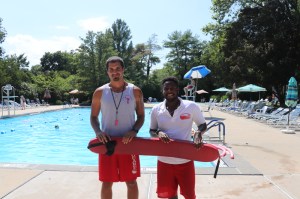
On July 21, the weekend of the major heatwave that hit Long Island, temperatures surpassed 95 degrees. The Roslyn Pines Pool and Tennis Club was filled with residents who came to escape the heat and cool off.
The day started out just like any other. Around 3 p.m., Justin Elder was on lifeguard duty scanning the pool when he heard someone scream for help.
Darin Frank, one of the three lifeguards on duty that day, remembers hearing the whistle blow three times which is a sign of an emergency and saw Elder jump into the pool. Following the scream, Elder noticed Lyle Greenman, 77, lying face down at the bottom of the pool. Quickly, Elder jumped in and pulled Greenman out of the pool. After safely securing Greenman to a backboard to keep his neck properly supported, three lifeguards moved Greenman to the shady area near the pool and checked for a pulse. Greenman’s skin was turning blue and he wasn’t breathing. While a pool patron called 911, Frank quickly began performing chest compressions while lifeguard Timothy Pecoraro simultaneously provided the breaths. After the third round of cardiopulmonary resuscitation (CPR), Greenman started breathing and began coughing.
“Everything happened so fast. That was the first time I ever did CPR on someone,” Frank recalled.
Frank has been a lifeguard for about seven years and owns an American Red Cross-certified first aid, CPR, AED (automated external defibrillator) and lifeguard training business with Elder’s older brother, Christian. Frank feels that his job as an instructor prepared him to act when it mattered most. Being an instructor and keeping up with his training helped him to act, rather than think, in this life-saving situation. Frank stressed the need for people to learn how to perform CPR.
“This could happen at any given moment, not just at a pool, in the street or at home. Someone’s life, if you’re trained, you could be the one to save it,” Frank said.
According to CPR.heart.org, “CPR, especially if administered immediately after cardiac arrest, can double or triple a person’s chance of survival. According to 2014 data, nearly 45 percent of out-of-hospital cardiac arrest victims survived when bystander CPR was administered.”
Approximately one week later, Greenman returned to the pool to thank the lifeguards for saving his life. While at the hospital, Greenman had surgery to put in a pacemaker. According to the lifeguards, Greenman doesn’t remember anything about the near drowning.
For more information about CPR training classes in the Nassau and Suffolk area, visit www.eliteaquaticstraining.com or email EATrainingLI@gmail.com.


























